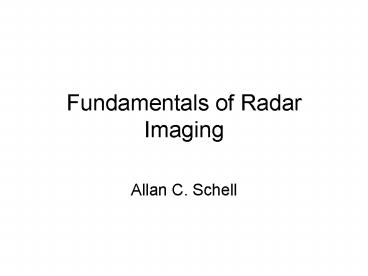Fundamentals of Radar Imaging PowerPoint PPT Presentation
1 / 54
Title: Fundamentals of Radar Imaging
1
Fundamentals of Radar Imaging
- Allan C. Schell
2
The Uses of an Antenna
3
Types of Imaging
- Coherent Source Imaging
- When phase is maintained on successive returns
- Incoherent Source Imaging
- When returns and/or sources are uncorrelated
4
Angular vs. Spatial Frequency FunctionsAngle
? Fourier Transform ? Spatial
Frequency
5
Imaging Properties of an Interferometer
6
Multiplicative Arrays
- A type of signal processing antenna consisting of
two arrays where the outputs are multiplied and
averaged - For incoherent sources, the output is
proportional to the product of the two antenna
field patterns - Examples
- Covington and Broten array, 1957
- Mills Cross Antenna, 1953
7
Multiplicative Arrays
- The voltage outputs of two antennas G1 and G2
scanning a source E are multiplied to form
G1G2 ?? F1 (u u) E (u) F2 (u u) E
(u) du du
If the source distribution is incoherent, the
averaged multiplier output is
Output ? F1 (u u) F2 (u u) T (u)
du where T EE
In the spatial frequency domain the antenna
transfer function is
Tau (s) ? f1 (x) f2 (s x) dx
8
The Mills Cross Array
9
Three Element Green Bank Interferometer16
collinear baselines12 hrs of tracks2700
MHzMax wavelengths24,200
10
Imaging Properties of an Interferometer
11
The Arsac Array
12
Imaging Systems and Error Criteria
13
Restoration in the Angular and Spatial Frequency
Domain
14
Restoration in the Presence of Noise
15
Superresolution Methods
16
Imaging Systems and Error Criteria
tR
tE
t tRtE at
17
Variational Calculus for Antennas
- Key distinction between time functions and
radiation patterns - Time functions obey causality
- Integrated radiation patterns equal ?2 /4p
- Consider an error function E (for example, the
mean square difference between a desired power
pattern PD and that of an array P. In the
spatial frequency domain - the error is (tD t)2 .)
- Let I be the Integral over the spatial frequency
range - Then I ? E du
18
Variational Calculus for Antennas (1)
19
Variational Calculus for Antennas (2)
20
Variational Calculus for Antennas (3)
21
Example A Minimum MSE Enhanced Output
- E restored output enhanced output over the
observed range of spatial frequencies 2 - added spatial frequency components to assure
positive definiteness of transform 2 - The range of integration is larger than the range
of received spatial frequencies - Slide 13
22
Outputs of the Array, the Restoration Filter, and
the Enhancement Processor
23
Enhancement Illustration - Two Sources
24
EnhancementIllustrationTwoEqual Sources
25
The Arsac Array
26
The Optimum Density Function for S/N 3.5
27
Transfer Function of an Optimum Array with 105
Element Spaces and S/N of 3.5
28
An Approximation to the Optimum Array for S/N
3.5
29
Digital Beamforming
30
Digital Beamforming
31
Definition
32
Digital Beamforming Capabilities
33
FFT Beamformer
34
Adaptive Nulling
35
Adaptive Nulling
36
Neural Network Beamformingfor Direction Finding
37
A Neural Network Direction Finding System
38
Antenna Pattern Correction after Element Failure
39
Antenna Pattern Correctionafter Element Failure
(cont.)
40
Antenna Pattern Correctionafter Element Failure
(cont.)
41
Experimental Results for Two Uncorrelated Sources
42
Array Architectures
43
An Array Antenna
44
Generic Passive Array Architecture
45
Generalized Array
46
Digital Beamforming Array
47
Serial Beamformer
48
Parallel (Systolic) Beamformer
49
Typical Digital Beamformer Receiver
50
A/D Converter Performance
51
A Digital Image Processing Array
52
Phased Array Trends
53
Typical Multilayer Printed Circuit Array
54
The End

